|
TennisOne Lessons Taylor Dent and Roger Federer Contrasting Service Deliveries Jim McLennan He keeps knocking at the door, and sooner or later he is coming in to the top echelon of the men's game that is and certainly when playing on court he is coming in; always coming in. A throwback to the style of Patrick Rafter or Stefan Edberg, Taylor Dent chips and charges, he serves and volleys, concluding nearly every point at the net. Somewhat like the 1992 US Open where Edberg swamped Courier with constant net rushing, Dent's style of play denies the opponent a sense of rhythm. He had a marvelous run at the recent US Open, nearly toppling Lleyton Hewitt in five hard fought sets. And throughout this year he has notched impressive wins over Marat Safin, Guillermo Coria, Ivan Ljubicic, Thomas Berdych, and Robbie Ginepri a pretty impressive year for the 24 year old player now ranked 24th in the world.
His service games are entirely serve and volley firm first volleys to the open court. If the opponent attempts a pass off this first volley, Dent cleverly angles the ball off with a deft touch. On the return game Dent rallies, content to stay in the point until a relatively short ball invites the approach. Or in other instances, as he has done with Agassi in past matches, his return of serve becomes the approach shot, denying the opponent rhythm, disabling the rally if that is what the opponent craves. This is classic hard court (read fast court) tennis. And it is no coincidence that Dent lists Patrick Rafter as one of his favorite players. A lot of similarities here - classic serve and volley, and a game that matured later when Rafter captured back to back US Open's in 1997 and 1998, the first victory coming when he was 24 years old. Two thoughts on Dent, but first a personal observation. I am hoping there are juniors who are learning from his style, for in spite of the predominant baseline game played by professionals and emulated by juniors, I will always believe (yes I am stubborn) that much can be gained (if not enjoyed) by moving forward when playing tennis.
I am always rooting for Dent in his matches and in his career as it progresses. That said, I have extreme reservations about his movement. Though most commentators question his fitness, I believe court coverage is as much about balance and grace as it is about fitness and endurance. When reviewing his serve and volley footwork, I am struck by his uneven stride length and a hurriedness that leads to imbalance. And I worry that he is surrounded by strength trainers rather than dance instructors. There is a gliding net rushing stride we saw with Edberg or Sampras, and when this kid learns how to move (really) his game will go to the next level. And now to his big serve. I think a comparison with others on the tour will show a number of areas where Dent can improve his disguise, his placement and his consistency. Sampras came in behind a deceptive serve; Edberg came in behind a huge kicker; Dent comes in behind a big serve, but with improvements in his delivery he can achieve even more success. The following stats may tell the story. The Ricoh ATP Match Facts rank the top ten players within many serving (and receiving) categories including aces, percentage of service games won, percentage of first serves won, percentage of second serves won, percentage of break points saved, and overall percentage of first serves placed in the court. Within these categories Taylor is listed in the top ten only in percentage of first serve points won he is 5th overall at 79% (interestingly Federer is 7th in this category at 77%).
When examining Dent's stats at the recent US Open, Dent's numbers were really more or less the same. Over 13 sets played in three rounds he averaged getting 47% of his first serves in play (as a reference, in the overall ATP Match Facts, Roddick is ranked 7th averaging getting 66% of his first serves in play). Dent won 77% of the points played on his first serve, and he won 48% of the points played on his second serve. Note that within the overall ATP Match Facts, as concerns percentage of points won on the second serve, Federer is ranked 1st winning 60% of these points while Agassi is ranked 10th winning 54% of these points. A closer look at Dent's US Open performance shows that in the first two rounds he was winning 52% on his first serve and 57% of the points played on his second serve, but against Lleyton Hewitt he only won 37% of the points played on his own second serve. Simply put, he needs a higher percentage on his fist serve (moving from 47% to 60% or more), and he needs to win more points on his second serve (moving 50% to again 60% or more). Silicon Coach Analysis
But this leads to an interesting question. Years ago the server had to keep at least one foot on the ground while serving, and it was in the early 60's (I think) when the rule changed and players were allowed to jump up and into the hit. So learning the serve in that era, we were taught to lean into the serve and bring our weight against the ball. But if you look at photos of Tiger Woods or Barry Bonds it appears more that they have turned into the hit while at the same time keeping their weight back. Well to my eye, there is a version of the serve similar to Woods and Bonds, where the server works up and into the hit without actually placing their weight against the ball. In sharp contrast to Taylor Dent, Roger Federer (and many others including Roddick and Sampras) appears to be moving up and into the hit, so much so that an instant after contact Federer is still rising. Not really pressing against the ball as Dent does, but rather going up after the ball. Let's take a closer look at the photos.
On the left Dent is crouched, balanced, his tossing arm up, and his hitting arm down and flexed. This looks great, however, in the photo on the right, taken from the identical service delivery, he has turned into the hit, but the yellow line shows that at impact he is standing no taller than he was at the bottom of his crouch. He has definitely brought his weight against the ball, but he has given up valuable inches (if not feet) at his point of contact. Further, I suspect that the movement of his upper body forward if not down at impact, is also influencing both his head and eyes.
Now in sharp contrast, the two photos of Federer are also taken in the same serving motion, but note the marked difference. On the left, much like Dent, Roger is balanced, his weight is back, his tossing arm is well extended and his eyes are up (trust me on this one for from this angle we can't really see his eyes). But in the photo on the right Federer has really moved up and into the hit. We see a similar hip turn, but Roger is serving tall. Further Roger is easily holding both his head and eyes up and this may simply be a result of his movement up and into the hit.
Additionally, while I can't show you a photo on this, I suspect Dent is losing points because his delivery lacks disguise, and I think his cramped style may just be the culprit on this. So my hunch is that when rising up and into the hit a number of positive things occur and this as important for you and I as it is for Taylor Dent. The higher the point of contact, the better the projection angle for the serve, for certainly Ivo Karlovic (6'10) has an advantage over Oliver Rochus (5'5) when serving. Second, when moving up and into the hit it will be easier to keep your head and eyes up during the contact event. And, as regards rhythm and efficiency, if one is swinging the arm and racquet up and into the hit (as Dent does and as you and I should) it makes more sense if one's body is moving in the same direction at that point in time. I believe Dent's service delivery and his resulting percentages will definitely improve when he feels how to get his weight up and into this hit. I am on Taylor Dent's side, always rooting for him, and sincerely wanting him to continue up the rankings into the top 10 and perhaps even higher, maybe a big result at a Grand Slam. But to get there I think the remaining issues are the dancing and the serve. Good luck Big Fella. Your comments are welcome. Let us know what you think about Jim McLennan's article by emailing us here at TennisOne.
|
|||||||||||

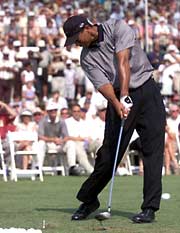
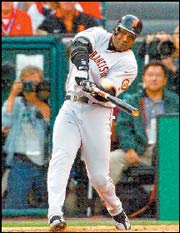
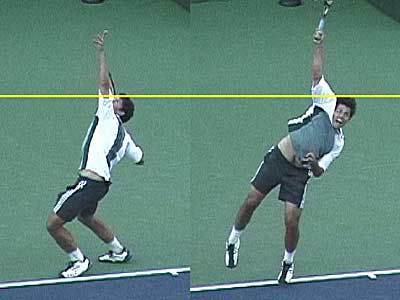 Using the drawing tools within Silicon Coach, I have highlighted Taylor Dent at the bottom of his crouch and at the moment of contact.
Using the drawing tools within Silicon Coach, I have highlighted Taylor Dent at the bottom of his crouch and at the moment of contact. 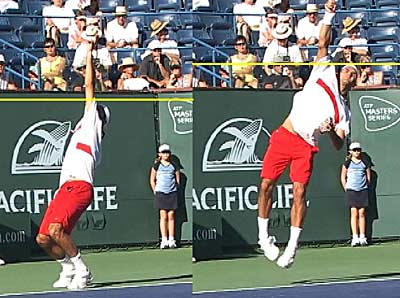 Imagine Sampras (or see Federer below) at impact the head and eyes were always up. (Note: the camera angles are just slightly different between Dent and Federer, and this different view may have contributed to the changes in serving height but I checked other files from a lower camera angle and found the same thing).
Imagine Sampras (or see Federer below) at impact the head and eyes were always up. (Note: the camera angles are just slightly different between Dent and Federer, and this different view may have contributed to the changes in serving height but I checked other files from a lower camera angle and found the same thing). 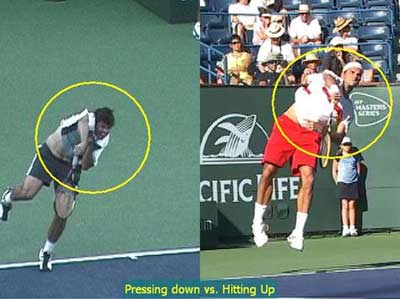 And finally, at a moment just after contact, the differences between pressing down and hitting up are yet again apparent. I think it is fair to say that one's percentages will improve with a higher point of contact. And equally it is fair so say that one's percentages will improve by watching the ball more carefully.
And finally, at a moment just after contact, the differences between pressing down and hitting up are yet again apparent. I think it is fair to say that one's percentages will improve with a higher point of contact. And equally it is fair so say that one's percentages will improve by watching the ball more carefully. 
